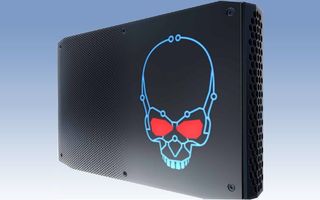Intel Issues Kaby Lake-G Driver Update After 12 Months, But It Comes From AMD
Intel issues updated drivers 12 months later

Update 03/29/2020, 3:10pm PT: Intel issued the driver update on 02/10/2020, meaning the driver delay lasted 12 months, not 14. The text has been amended.
Original Article:
After leaving its Hades Canyon NUC customers without new Vega GPU drivers for 12 months, Intel has quietly stopped providing its own Intel-branded and validated graphics drivers for Kaby Lake-G processors and now allows customers to use AMD's mainline graphics drivers.
In a partnership that defied the laws of nature, bitter rivals Intel and AMD collaborated on the Kaby Lake G processors that debuted back in Hades Canyon NUCs in 2017. These chips featured a discrete AMD Radeon RX Vega M graphics unit paired with Intel's Kaby Lake processing cores in a single package, thus providing Intel a capable chip with impressive gaming performance for its enthusiast-geared NUCs.
This unnatural act may have yielded award-winning levels of performance, but Intel killed the project in October 2019 as it switched focus to its own Xe Graphics Architecture for future products. However, Intel was still responsible for validating, branding, and delivering the graphics drivers for the Radeon Vega GPU. Despite the company's termination of the project, it promised to provide driver updates for five years.
Regardless of those assurances, we noticed that Intel didn't issue a Vega driver update for a year, leaving its customers stranded without day zero game updates since February 2019. We reached out to Intel in January 2020 to check on the status of the graphics drivers for Hades Canyon NUCs, to which the company responded:
"8th Gen Intel Core processors with discrete graphics will follow Intel’s typical driver support model, which is to provide driver updates for about five years following the launch of a product. OEMs and customers will get their drivers and support directly from Intel. We are currently working on the next graphics driver update, and we expect the next driver to be available in the coming months."
Stay on the Cutting Edge
Join the experts who read Tom's Hardware for the inside track on enthusiast PC tech news — and have for over 25 years. We'll send breaking news and in-depth reviews of CPUs, GPUs, AI, maker hardware and more straight to your inbox.
Twelve months after the last driver update, Intel quietly issued a new 'driver download' that went unnoticed, but it is merely a PDF that instructs users to head over to an AMD download portal for Radeon RX Vega 64 graphics drivers. The new drivers consist of AMD's mainline Adrenalin 2020 drivers, meaning that Hades Canyon NUC customers can install AMD's latest drivers, thus receiving important performance boosts for new games and the other advantages that come along with new drivers.
The move may seem small, but Intel effectively left its Hades Canyon customers stranded without up-to-date support for a year. That isn't a good look for a company that asks its customers to adopt radical new technologies on a fairly regular basis.
As an interesting aside, the Radeon Vega Graphics inside the Hades Canyon NUCs came along with their own controversy, as many noted they were more similar to Polaris than Vega due to the varying IP blocks Intel used for the design (we also see some of the same controversy emerging over the RDNA 2 graphics in the Xbox Series X and Sony PS5). You can read our Kaby Lake-G Vega investigation here.

Paul Alcorn is the Managing Editor: News and Emerging Tech for Tom's Hardware US. He also writes news and reviews on CPUs, storage, and enterprise hardware.
-
watzupken This is certainly a bad experience from Intel. If they don't want to support it, at least open it up and let users download drivers from AMD. It should not take a year before they allow people to do that. I am not sure what is the motive of restricting, but it certainly backfires at them for poor after sales support.Reply -
cyrusfox This is normal and not much of a story.Reply
You could always install the latest AMD GPU driver, the risk is the same anytime you update a GPU driver, you could have issues though(That still does not go away as these are not actively being validated).
It is the same with a laptops and discrete GPU, go take a look at the graphic drivers included from the manufactureres website, Usually it is the original driver when the laptop released... You can always update to latest(Some for like HP you need to install directly but there is always a way to add them). The OEM/manufacturers seldom will revalidate old platforms unless there isa big performance or security bug included in the initial drivers. That's why this is expected behavior, you'll get a functioning driver from the OEM, but if you want the best performance you'll ahve to take the risk of using a direct AMD/NVIDIA driver that was just released but hasn't been and likely never will be fully validated for your unique product. -
truerock I've stopped using OEM drivers that do not come in Windows 10 updates.Reply
I rebuilt my 2012 PC with Windows 10 two weeks ago and I used no OEM drivers.
About 6 months ago I had the latest nVidia driver for my Geforce GT 690 video card and I started having an issue with a particular new application. I uninstalled the nVidia driver from nVidia and let Windows 10 download an update of a video driver that was about 6 months older and all my problems disappeared.
Most Popular






